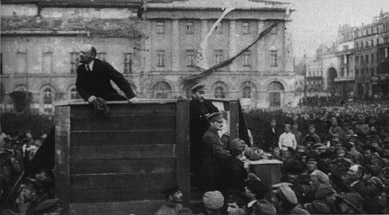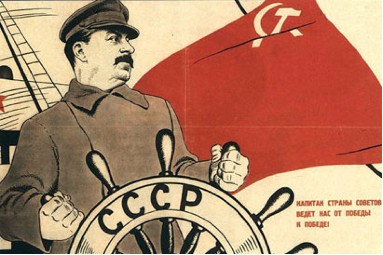USSR under Stalin
After Lenin's death there was a struggle for power between Stalin and Trotsky. Trotsky wanted revolution to spread to other countries. Stalin was content for Communism to stay within just one country for the moment. Stalin controlled the party. Trotsky was isolated and thrown out of the Communist Party (1927). Trotsky was finally murdered in Mexico by Ramón Mercader, a fanatic spanish stalinst.


Under Stalin the state planned industry and agriculture with a commission called Gosplan. A Five-Year Plan set targets for all basic industrial factories and workers. They started in 1928. In 10 years the USSR had almost doubled its industrial output but the price was misery and low living standards for Soviet workers.
Private property disappeared. It was important to increase food production to supply workers in towns and cities. In 1929 Stalin began collectivising all farms (kolkhos). Another type of collectivisation were the state farms (sovkhos): owned completely by the state, peasants worked as labourers, so they received wages even if the farm did badly.
Some peasants refused this change and did not want to give up lands, especially the kulaks (richer peasants). Stalin called them enemies of the people. Around 10 million were shot or sent to Labour Camps, many died from starvation or cold. Many kulaks burned their crops and killed livestock. This caused a famine in Ukraine where 5 million people died.
By 1937 collectivization was almost completed, kulaks had been eliminated and the peasants were afraid of Communist powers.
Stalin turned the Soviet Union into a personal dictatorship where the communist ideal was still alive but filtered by his powerful personality. He ruled over the USSR using three tools.
- Cult of personality. Stalin became omnipresent by means of propaganda. There were pictures of him everywhere. He was the father, the husband, the grandfather of every Russian. This presence was reinforced by the World War II.
- The Party. During Stalinism, the only way to be promoted, the only way of being someone was by strict adherence to the ideas of the Communist Party
- The terror. Stalin set up a secret service network that controlled every citizen of the Soviet Union. The NKVD was managed by Lavrentiy Beria. In the late 1930s they purged many members of the party (Moscow Trials) by sending them to concentration camps in Siberia (Gulags)
